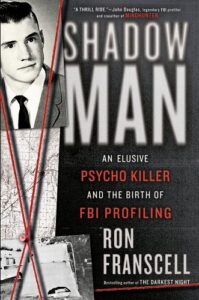In 1974, just two years after the FBI Academy opened, Patrick Mullany and Howard Teten were up to their elbows in bizarre cases. They were wading around in the blood let by freakish psychopaths like Ed Kemper, a family-killing necrophiliac who screwed the severed heads of his victims and slept with their bodies. Each case added to their understanding of criminal minds, but more and more research and interviewing criminals meant less and less time for helping fellow agents and local cops.
The two agents had started to see a direct link between specific mental disorders and certain crimes: A true psychopath could commit any crime at any time and possessed a bottomless appetite for violence; a paranoiac tended to act alone and had an assassin’s bent; manic-depressives gravitated toward murder-suicides; and simple schizophrenics were inclined to linger with their corpses, sometimes literally and figuratively burrowing into them. Nothing was set in stone, but the penchants were real.
Truth be told, Mullany and Teten had very little scientific data about criminal minds. Most of their assumptions were based on their own cop work, gut feelings, and educated guesswork. Some FBI higher-ups backed their research, but Director J. Edgar Hoover thought what they were doing was hokum, so they were kept on a short leash, operating quietly. They’d occasionally drop in at San Quentin or Sing Sing to chat with killers and rapists, never really seeking official approval that might never come. It was better to ask forgiveness than permission.
While they had offered a lot of good advice to cops about what their UnSubs might be like, they’d never actually constructed a profile that helped investigators arrest a killer. First of all, it wasn’t the purpose of their work to magically identify murderers by name. Second, while their research was leading them to compile more information about forensic psychology than anyone, they weren’t seeing a direct correlation between their work and solving crimes. They wanted more of a system, and profiling wasn’t lending itself to a system. A certain proportion of agents was resistant to this new “headshrinker” approach, so Teten and Mullany knew they risked banjaxing the whole enterprise if they crashed and burned.
Yet the torrent of exasperated detectives never stopped. In April 1974, yet another one walked through Pat Mullany’s door, wearing cowboy boots.
FBI special agent Pete Dunbar, a field agent on the frayed edge of civilization—otherwise known as Montana—had fidgeted through a daylong criminal psychology seminar, constantly superimposing what he was hearing on the cases of Susie Jaeger and Sandra Smallegan.
When the class ended, he didn’t wait for an invitation. He followed Mullany to his puny office and soon spilled his grim story all over the profiler’s neat little desk. He hadn’t brought his case file to Quantico, but enough filled Dunbar’s head to arouse Mullany’s interest.
One problem: Dunbar’s case, in reality, involved only two kidnappings, and they weren’t clearly related. They involved dissimilar victims abducted in very different ways. Smallegan was certainly dead; Susie was likely dead, too. The trail had gone cold, and the investigation stalled. No autopsies, no suspects, no leads—only the forensic presumption that the bones at the Lockhart Ranch belonged to both Susie Jaeger and Sandra Smallegan, and their intermingling suggested the same kidnapper, who was probably a killer, too.
The presence of Sandy’s car at the ranch could have been just a coincidence.
Or not.
Mullany didn’t believe in coincidence. He believed Dunbar was on the right track. He had a gut feeling both girls were dead. But gut feelings were crap. He had to be able to connect real dots. He had to see the hard evidence.
When Mullany shared Dunbar’s perplexing case with him later that night, Teten was more skeptical. It wasn’t a particularly unusual case, and with dozens of more pressing and solvable mass murders—they had tossed around a potential new term, “serial killings”—he was lukewarm.
That changed when Dunbar went home to Bozeman, collected his entire case file in a box, and sent it to Quantico. Photographs, interviews, forensic reports from the Lockhart place, long lists of evidence, even the transcript of the ransom call— it was there in all its violent colors.
Sorting through all the paperwork, Mullany and Teten were disappointed by the unprofessional reports from untrained or poorly trained deputies. Photos were of questionable quality. And Dunbar had no conspicuous suspects, no existing leads, not even hunches. It was obvious to them why the agent was disheartened.
But there was something intriguing about this crime, something they hadn’t seen before: a kidnapper who had taken both a seven-year-old girl and a nineteen- year- old woman, one victim chosen seemingly at random, the other specifically targeted. What if he had killed them both, burned them into tiny pieces, and scattered their bones to the wind? How had he eluded attention in such a sparsely populated place, especially with cops crawling all over the county?
Could this man—and he was most certainly a man—add to what they already knew about criminal psychology?
Moreover, could this be the first active FBI case to test whether criminal profiling was useful, maybe even valuable?
Yeah, it was.
Just like that, SA Pete Dunbar’s case became the top priority for the only two guys in the Bureau who might know more about Susie and Sandy’s killer than any cop on the ground two thousand miles west of Quantico, Virginia.
***
Even before they’d burrowed to the bottom of Dunbar’s box, Mullany and Teten had a broad-brush impression of the UnSub, based on the circumstances of the abductions and the victimology. They focused mostly on Susie’s abduction. It had the most crime-scene information and it was no ordinary kidnapping.
They were handicapped by a lack of hard evidence. All they had was a slit tent in a campground with plenty of other campers close by, and a trail of footprints in the dewy grass. No body, no weapon, no witnesses, no blood.
They started with a central, if imperfect, premise: An adult male boldly snatched a child without inflicting any serious injury and took her to a secret location, and she couldn’t be found.
Most crime scenes yielded a lot of information about the perpetrator. But not this one. Every element of their profile must be based on those scant facts, and maybe a little intuition.
As a starting point, Teten and Mullany presumed the UnSub to be a subtle combination of simple schizophrenia and sadistic psychopathy, probably with some kind of sexual component, almost certainly a mother or father issue. Their profile unfolded from there, starting on a disheartening note:
Susie was probably dead within two days. After the “golden hour”—one hour after a disappearance—the likelihood of death becomes exponentially higher. Considering the likelihood that Susie’s bone shards had been found at the Lockhart Ranch last February, it was not a question of whether she’d been murdered, but when.
The UnSub was probably a white male in his mid-to late twenties. His race was a low-risk deduction: Gallatin County was almost exclusively white. And the psychotic killers Teten and Mullany studied—murderous shoe fetishist Jerry Brudos, homosexual sadist Dean Corll, psychotic visionary Herb Mullin, and cannibal necrophile Ed Kemper, among others—had mostly started their killings in their twenties and early thirties.
He was at least modestly intelligent. Susie’s kidnapping showed a highly organized thinker who anticipated every investigative move. There was a remarkable level of planning and organization. The UnSub took her to another location, instead of dumping her, which would have been easier. But he had a stronger, more developed fantasy. He brought a knife and was able to move around in the dark. He drove an inconspicuous vehicle and knew exactly where to park— ar enough to be unsuspected but close enough for a quick getaway. Even worse for Dunbar and other investigators, the UnSub had already picked a place to take her with almost no chance of discovery.
He was a loner, unmarried, and probably had little experience with women—and when he did, it didn’t last. In fact, his whole history of heterosexual relationships would be defective. They presumed he was such a sophisticated psychopath that he’d never trust anyone long enough to have a long-term married relationship. Sure, married perps have twists and kinks, too, but it was a good chance this UnSub wouldn’t be interested in a real marriage. But Teten and Mullany didn’t have enough evidence to know for sure; it was just an educated guess.
He had military experience. There were three other children in Susie Jaeger’s tent. Her parents were in a trailer a few feet away. Other tourists camped nearby. This abduction had required extraordinary stealth, patient reconnaissance, and boldness under cover of darkness. He had to be fit enough to carry a struggling fifty-pound child as he ran through a dark park, keeping her quiet the whole time. Mullany felt strongly he would be more like a combat veteran than a Peeping Tom. Besides all that, if he was as young as they thought—draftable during the ongoing Vietnam War—the odds that he had served in the military were good.
He’d thrive in solitary jobs where he needn’t interact with other workers. Everybody has three different lives: professional, personal, and secret. Deeply disturbed criminals work hardest to protect their secret lives. The UnSub would have been most vulnerable among coworkers and bosses who’d constantly watch him, possibly detecting clues about his deepest, darkest secrets. So he’d avoid that kind of exposure by working alone.
He had likely stumbled on the tent in the campground where Susie Jaeger was snatched. But he quickly began planning his next move, probably savoring the risks it might require.
He lived in the area. In fact, he was well-known to local folks but regarded as odd. The UnSub had to know the park’s layout and the places he could hide her. His boldness suggested he didn’t fear getting caught by local law enforcement, whom he knew well enough to regard as Keystone Kops. An outsider wouldn’t have been so confident. Also, the possibility that Sandra Smallegan’s disappearance almost eight months later was related made them think the UnSub didn’t look like a stranger to locals who thought they knew everybody. Confidence in his own invisibility might cause mistakes. Arrogance would ultimately be his worst enemy, the profilers told Dunbar.
Socially, the UnSub was friendly but never truly companionable. While not genuinely aloof, he wouldn’t inject himself unnecessarily into any social situation. He’d float around the edges of any group. He probably didn’t even realize that people considered him odd.
The deeper they dug into Dunbar’s box, the more complicated their UnSub became. Mullany and Teten talked endlessly about it, and they even brought in a fledgling agent named Robert Ressler as an apprentice in their nascent undertaking. They schlepped the case file around to other agents in Quantico, and called Dunbar at all hours of the day with enigmatic questions that seemed, to him, to create new mysteries where there were none. The more questions they asked, the more they sensed he was starting to question whether this “profiling” thing was meaningful crime fighting or just concocted bunk.
They weren’t sure themselves. Yeah, Dr. Brussel had hit the bull’s‑eye on George Metesky twenty years before, but nobody had succeeded so spectacularly since then, or even tried. They were in uncharted territory, and failure in this case could unravel their grand experiment entirely with their bosses. Hoover’s ghost would win.
Dunbar’s discomfort wasn’t unexpected. Even though he’d sought their help, his trust remained in conventional police work—just like with Brussel and the NYPD. At least Dunbar was open to the potential of profiling as a crime- solving tool, although he seemed to be questioning it now.
Teten and Mullany couldn’t look back. They couldn’t afford to fail. Their only option was to forge ahead as if they’d done a million criminal profiles—instead of never having done one before.
The profile in Susie Jager’s case needed to be more robust, they decided. And it had to be fast.
Over the next few weeks, they bored deeper into a brain that existed only in their brains.
And what they found—or imagined—was disturbing.
The UnSub had probably killed before. The snatching of Susie Jaeger was too sophisticated, too flawless, for a skittish beginner. He wasn’t experimenting. And when he killed, it was to maintain his control, superiority, and dominance.
His mother was domineering, and his father was absent or unknown. Ed Kemper— who shot his grandparents and later slaughtered his own mother, decapitating her, cutting off her hands, and stuffing her dismembered larynx down her sink’s garbage disposal—was their keenest model. He’d made them believe that every psychopath was damaged by one or both of his parents in some way, whether by abuse, abandonment, or, oddly, too much affection. Such a psychopath’s victims were often vulnerable, innocent, accessible surrogates for the person he really wanted to kill: Mom or Dad . . . or both.
He was fascinated with body parts. It was becoming increasingly common for psychotic killers, such as Kemper, to retain pieces of their victims. In fact, Teten and Mullany told a skeptical Dunbar, if the UnSub was ever arrested, investigators would likely find ugly “souvenirs” he had taken from his corpses. Why? Again, it was about his need for power and control. As long as he owned their body parts, he owned his victims, too. In his mind, even death didn’t free them from his domination.
He’d find a way to insert himself into the investigation. He wanted to know what the cops knew, and he loved the thrill of being right in front of their stupid eyes, like a moth dancing defiantly in front of the flame. He might even try to lead them astray, Teten and Mullany warned. At any rate, he’d be reliving the high he got from the murder and playing a secret game that showed he was in control, not them. The UnSub’s ultimate goal of control included fostering and maintaining a sense of mystery about himself. Revealing his truth would diminish the enigma he was. He was, in short, a narcissist who believed he was smarter than them.
And risk turned him on. How could they presume anything else about a man who’d snatch a child in the dark while she slept in a tent inches from her siblings, surrounded by a dozen other campers?
There might be a “God element.” It might show up as twisted zealotry or distorted religious anger—or it might not—but in any case, the UnSub probably grew up in the area, which was devoutly Christian. Teten and Mullany couldn’t be sure church played a role, but they agreed it wouldn’t surprise them.
And, finally, this was a very emotional crime for the UnSub. In fact, his intense connection to the abduction and to Susie meant that he’d reach out to her family, probably on a date that was important to him. Maybe the date of her abduction or the exact time he had killed her.
Why? He would want to extend his crime to the family. He was still deriving pleasure from it. He wanted to mock and torment the family as a kind of celebration of his cunning.
So they advised Dunbar to attach a tape recorder to the Jaegers’ home phone in Farmington Hills, Michigan, and to be ready to quickly trace any incoming calls. Dunbar seemed relieved. Finally, something that sounded like real police work.
___________________________________
Excerpted from Shadowman: An Elusive Psycho Killer and the Birth of FBI Profiling, by Ron Franscell. Copyright 2022, Ron Franscell. Published by Berkley Books Reprinted with permission. All rights reserved.
















